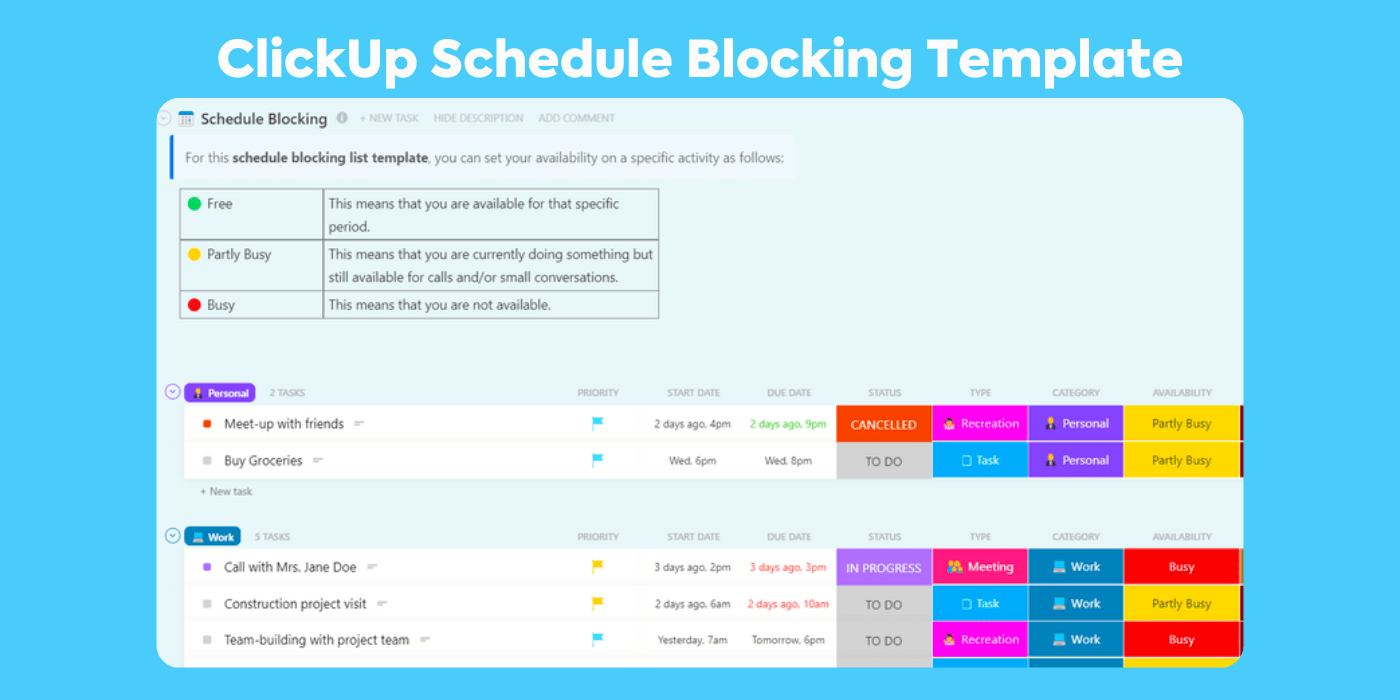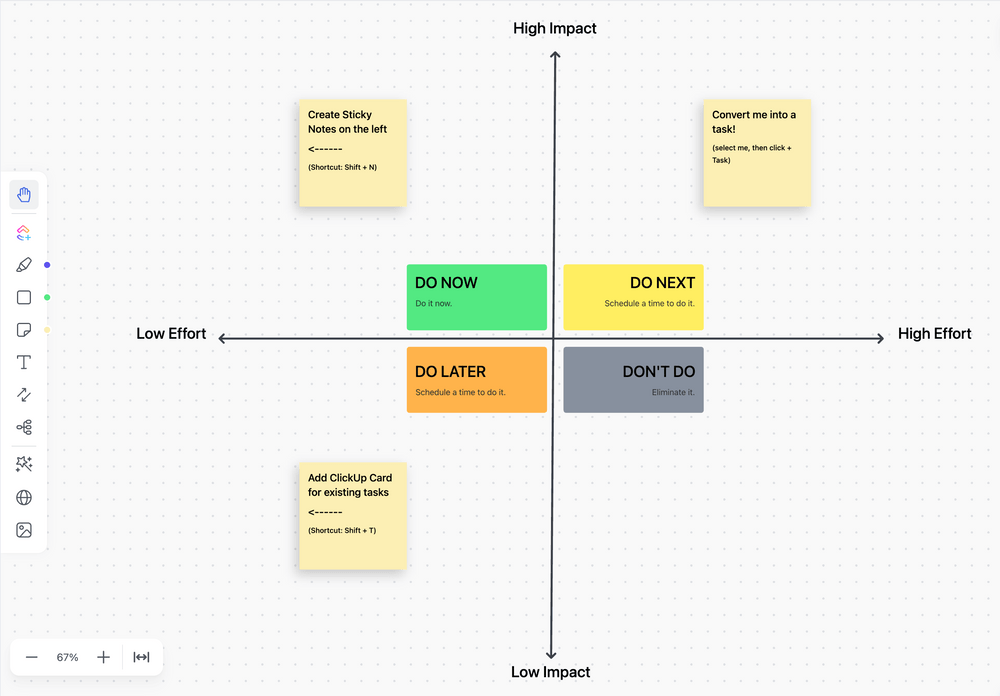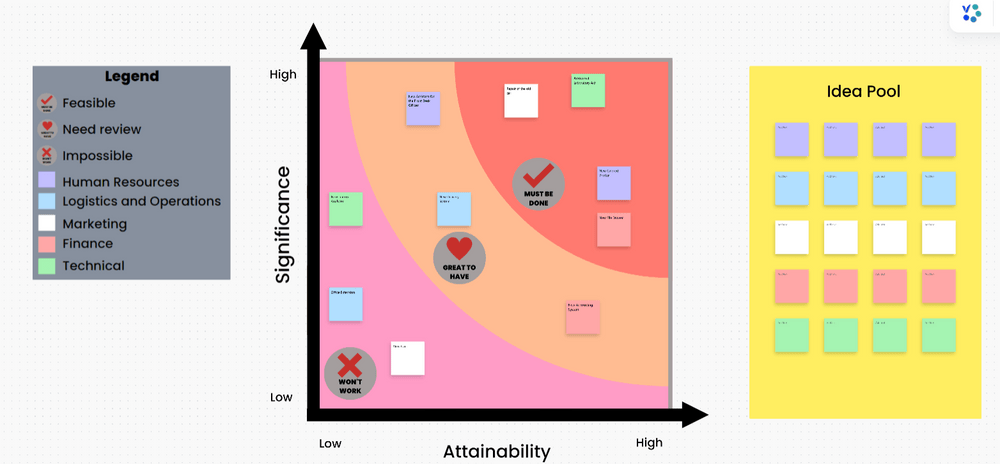هل كل مهمة في خط سير العمل لديك عاجلة بنفس القدر؟
هل تقوم بـ قائمة مهام بسيطة وإنجاز كل مهمة من البداية إلى النهاية؟
حسنًا، إذا كان الأمر كذلك، فهذه علامة حمراء كبيرة.
لماذا؟
إذا كنت لا تقوم بترتيب أولويات المهام، فإن الأمر مجرد مسألة وقت حتى تصبح عنق الزجاجة المزمن في المشروع. عندما لا تعرف كيف تحديد أولويات المشاريع بناءً على إنتاجيتك أو إنتاجية فريقك، يمكن أن يضر عملك بشكل كبير.
فبدون أي تسلسل هرمي في مهامك، فإنك تتعارض مع مهارات إدارة الفريق مما يؤدي فقط إلى بيئات فريق غير صحية. إذا كان فريقك لا يثق بك في معالجة المهام الأكثر إلحاحًا، فمن المحتمل أن يتجنبوا طلب المساعدة منك.
كل ما سيفعله ذلك هو خلق فوضى في المشروع.
لذا، ربما نبتعد تمامًا عن هذا السيناريو ونتعلم أفضل الطرق لتحديد أولويات المهام. هذا هو دليلك للتركيز بشكل أفضل على المهام الأكثر أهمية أولاً، وبث الثقة في فريقك، وتجنب تفويت المواعيد النهائية.

## 8 خطوات لتحديد أولويات المهام في العمل
إن معرفة ما هي المهام التي يمكن معالجتها الآن أو لاحقاً سيؤثر على نجاح مشروعك. من عدم انخراط الموظفين وتغيّبهم عن العمل إلى انخفاض الأداء والإنتاجية، يؤثر عدم تحديد أولويات المهام بكفاءة على المشاريع الكبيرة والمعقدة.
وفي النهاية، تعتمد النتيجة النهائية لشركتك على ذلك. لهذا السبب يجب أن تفهم كيفية تحديد أولويات المهام لإدارة وقتك وتحديد الأولويات بين فريقك.
إذا كان فريقك يعتقد أنك ببساطة ستكمل المهام لأنك مديرهم, تواصل الفريق قد بدأ بالفعل في التفكك. إن تحديد أولويات المهام أمر بالغ الأهمية للفرق عالية الأداء، ولكن ما الذي يمكنك فعله لمعالجة هذه المشكلة؟
1. رتب مهامك دون ترتيب هرمي معين
في البداية، اكتب قائمة بجميع مهامك. قم بتضمين كل من المهام الجارية والمستقبلية لجميع مشاريعك في قائمة المهام هذه. ولا تترك أيًا منها خارج قائمة المهام لأي سبب من الأسباب.
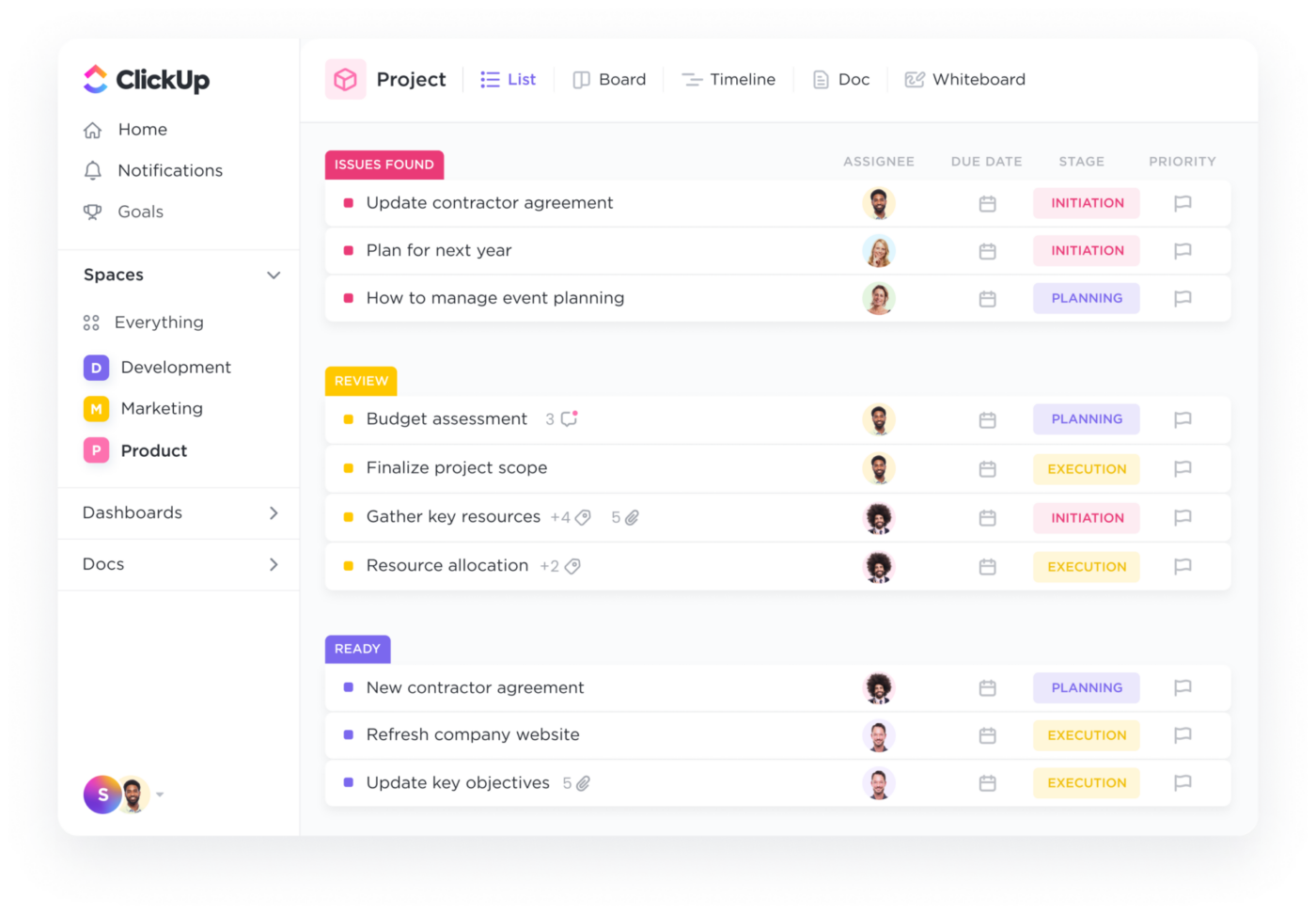
قم بتجميع مهامك في ClickUp لتصور العمل بسهولة أو تخصيص قائمتك حسب رغبتك
قد يبدو هذا أمراً يمكن الاستغناء عنه. ومع ذلك، فإن تحديد الأولويات وإدارة المهام بفعالية في رؤوسنا هو وهم. بالتأكيد، قد يكون ذلك ممكناً للمشاريع الصغيرة التي يقوم بها شخص واحد، لكنه سيكون ملحمة بالنسبة لمعظم المشاريع.
يجب أن تكون لديك الصورة الكاملة لجميع مهامك قيد التنفيذ والمجدولة والتي لم تبدأ بعد في مكان واحد خارج رأسك. وبالنسبة للبعض، يجب أن تكون غير مرتبة حتى لا تكون مجرد قائمة أو تعامل جميع المهام بنفس الطريقة.
بدلاً من ذلك، حاول تحديد أولويات المهام وتوصيل الأولويات إلى فريقك. وهذه هي الطريقة التي تمكنك من إدارة عبء العمل والحصول على فكرة عن قائمة الأولويات حتى تتمكن من إعادة توزيعها إذا لزم الأمر.
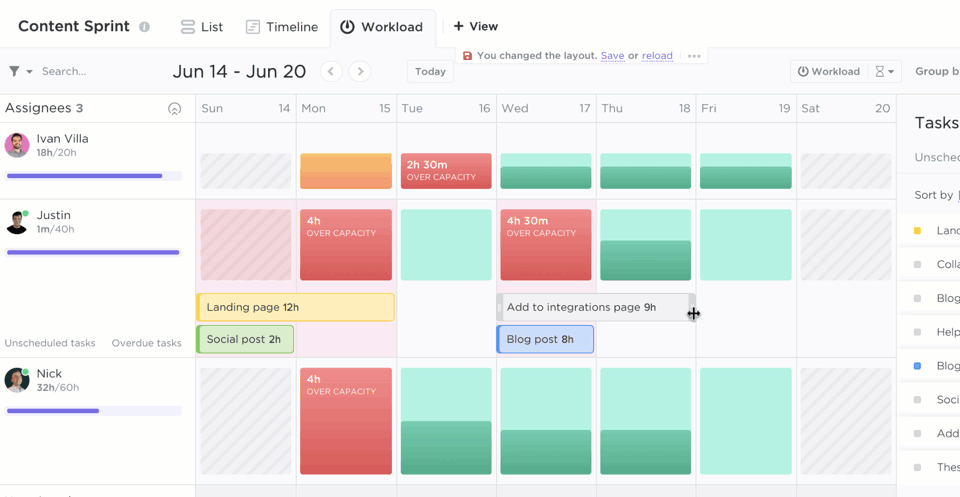
استخدم طريقة عرض عبء العمل في ClickUp لمعرفة من هو متقدم أو متأخر وسحب المهام وإفلاتها بسهولة لإعادة تخصيص الموارد
ابدأ دائمًا بإنشاء قائمتك أولاً لا تحاول تخطي خطوة قائمة المهام لتسريع الأمور! فهذا فخ. ولن تكون قادرًا على تجنب جميع التكاليف الباهظة لعدم تحديد أولويات المهام التي ناقشناها سابقًا. قسّم المهام الأكبر إلى مهام فرعية. هذا يبسط الخطوات التالية، وفي برنامج إدارة المهام مثل انقر فوق يمكنك حتى إعادة ترتيب أو تعديل المهام الفرعية بشكل مجمّع.
ليست هناك حاجة لترتيب المهام في القائمة الآن. ولكن هذا توقيت ممتاز لتجميعها حسب اليوم والأسبوع والشهر والسنة. والأمر نفسه ينطبق على إضافة مدة وتاريخ استحقاق لكل مهمة.
انتبه إلى أن المهام لا تتألف فقط من العمل على مخرجات المشروع . وهي أيضًا الاجتماعات والمكالمات الهاتفية ومكالمات الفيديو والعروض التقديمية والرد على الرسائل الفورية ورسائل البريد الإلكتروني. ولكن عادةً ما تكون هذه خطوات ضمن المهام.
لتجميع قائمة المهام الخاصة بك، استخدم القلم والورقة أو ClickUp. لكن دعنا نخبرك بشيء: استخدام أداة ما يسهل عليك المهمة التي لا تنتهي لتحديث القائمة كلما ظهرت مهام جديدة. وهذا تحديد أولويات المهام و طريقة إدارة الوقت يمكن أن توفر الكثير من الوقت. تنظيم المهام باستخدام بدائل تاسكاد !
2. حدد المهام التي يجب عليك القيام بها أولاً
نشعر جميعًا بأننا مضطرون للقيام بالمهام الصغيرة والسهلة والسريعة أولاً، بغض النظر عن أولويتها. هذه هي التحيز للإنجاز يركلنا. بالإضافة إلى ذلك، تظهر الدراسات أن دماغنا يطلق الدوبامين في مجرى الدم عندما ننتهي من المهام المهمة، وهو ما يجعلنا مدمنين على الاستمرار في القيام بها.
ولكن يجب عليك مقاومة ذلك! ويمكنك القيام بذلك عن طريق:
التمييز بين المهام المهمة والعاجلة
ما هي المهمة المهمة المهمة؟ وما هي المهمة العاجلة؟
لا شك أن المهمة المهمة المهمة غير العاجلة يجب أن تكون على قائمة مهامك. يجب عليك جدولة المهمة، ولكنك لست بحاجة إلى تنفيذها على الفور. يمكنك في الواقع تأجيل المهمة.
من ناحية أخرى، يجب عليك تنفيذ المهام العاجلة والمهمة اليوم أو في الساعات القليلة القادمة. لكنها ليست بالضرورة مهام مهمة، لذا يمكنك تفويض شخص آخر لتنفيذها.
ثم، من المحتمل أن يكون لديك مهام أخرى مهمة وعاجلة في نفس الوقت. يجب عليك القيام بها على الفور لتجنب الآثار السلبية الخطيرة، مثل تفويت الموعد النهائي للعميل أو خسارة عقد عميل أو عدم إطلاق منتج أو عدم إطلاق خدمة.
أخيرًا، بعض مهامك اليومية ليست مهمة ولا عاجلة. وهذا يعني أنه يمكنك حذفها من قائمة مهامك دون التسبب في أي تأثير سلبي على الفريق أو القسم أو الشركة بأكملها.
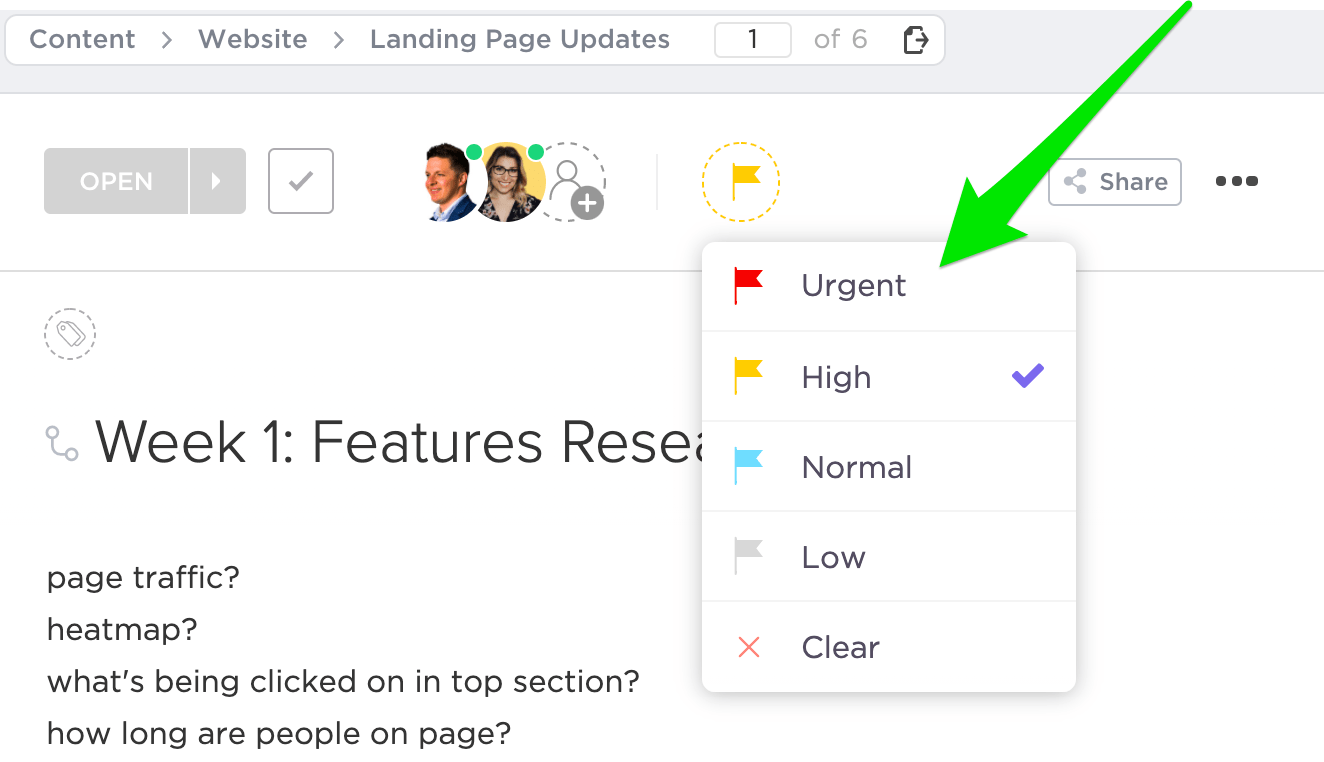
قم بتعيين الأولويات في ClickUp للتمييز بشكل أفضل بين ما يجب القيام به الآن وما يمكن تأجيله
يسمح لك ClickUp بإضافة علامات مخصصة للمهام لتمييزها على أنها مهمة أو عاجلة أو كلاهما أو لا شيء. بالإضافة إلى ذلك، يمكن تعيين جميع المهام إلى أولويات محددة مثل عاجل، عالية، عادية، عادية، منخفضة.
ترتيب المهام حسب قيمتها
أي من مهامك تجلب قيمة عالية للعمل؟ هذه المهام هي أولويات، ولكن ليست جميعها ذات أولوية.
تعتمد أولويتها على قيمتها. المهام الحرجة هي مهام عاجلة وذات قيمة عالية. المهام ذات الأولوية العالية ليست عاجلة، لكنها تجلب قيمة عالية للعمل. المهام ذات الأولوية المتوسطة هي مهام عاجلة ولكنها منخفضة القيمة. وأخيرًا، المهام ذات الأولوية المنخفضة هي مهام غير عاجلة ومنخفضة القيمة.
فيما يلي بعض الأمثلة على المهام ذات القيمة العالية لأي عمل:
- القيام بعمل مشروع العميل (على عمل المشروع الداخلي)
- إصلاح الوصول إلى منصة عقد مؤتمرات الفيديو الخاصة بالشركة عن بُعد (قبل البحث عن بديل أعلى جودة)
- الرد على تذاكر دعم العملاء (بدلاً من إعادة تصميم موقعك الإلكتروني)
- وصف متطلبات المنتج الجديد الذي سيقوم فريقك ببنائه (بدلاً من مهمة لا يعتمد عليها الفريق)
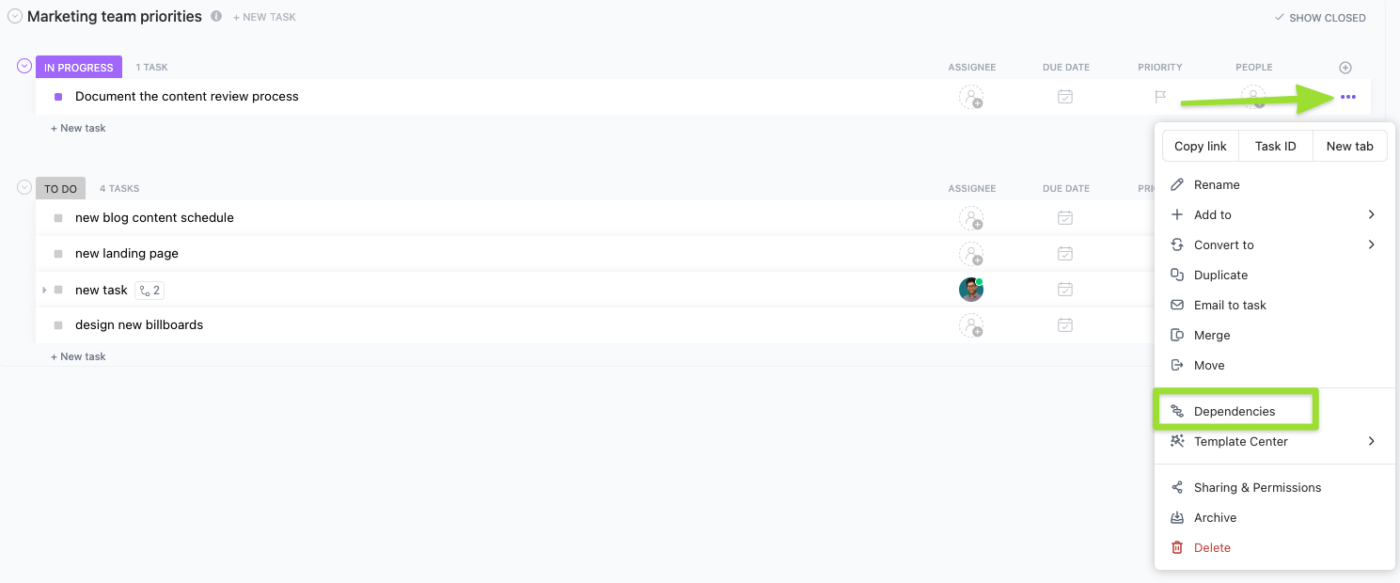
من السهل عرض تبعيات مهامك في طريقة عرض القائمة في ClickUp ومعرفة ما يحتاج إلى اهتمامك أولاً بسرعة
قم بإنشاء علاقات بين مهامك وفريقك في ClickUp للتنقل عبر كل مهمة والتحقق من الحالة بسهولة. بالإضافة إلى ذلك، يمكنك استخدام ClickUp لتعيين التبعيات للمهام وتحديد ترتيب تنفيذها في نهاية المطاف.
رتب المهام المهمة حسب الجهد المبذول
إذا كنت ترغب في إعداد يومك للإنتاجية، فاعتمد على تقديرات الجهد. هذا يعني أنه يجب عليك إكمال المهمة الأعلى جهداً أولاً قبل القيام بأي شيء آخر كل يوم.
وغالبًا ما تكون المهام الأعلى جهدًا هي المهام الأكثر تعقيدًا في اليوم أو تلك المرتبطة بقوة بـ oKRs الخاصة بالشركة . إن التعامل معها أولًا بأول كل يوم يقلل بشكل كبير من مستوى التوتر لديك مع خلق الزخم وتعزيز الحافز.
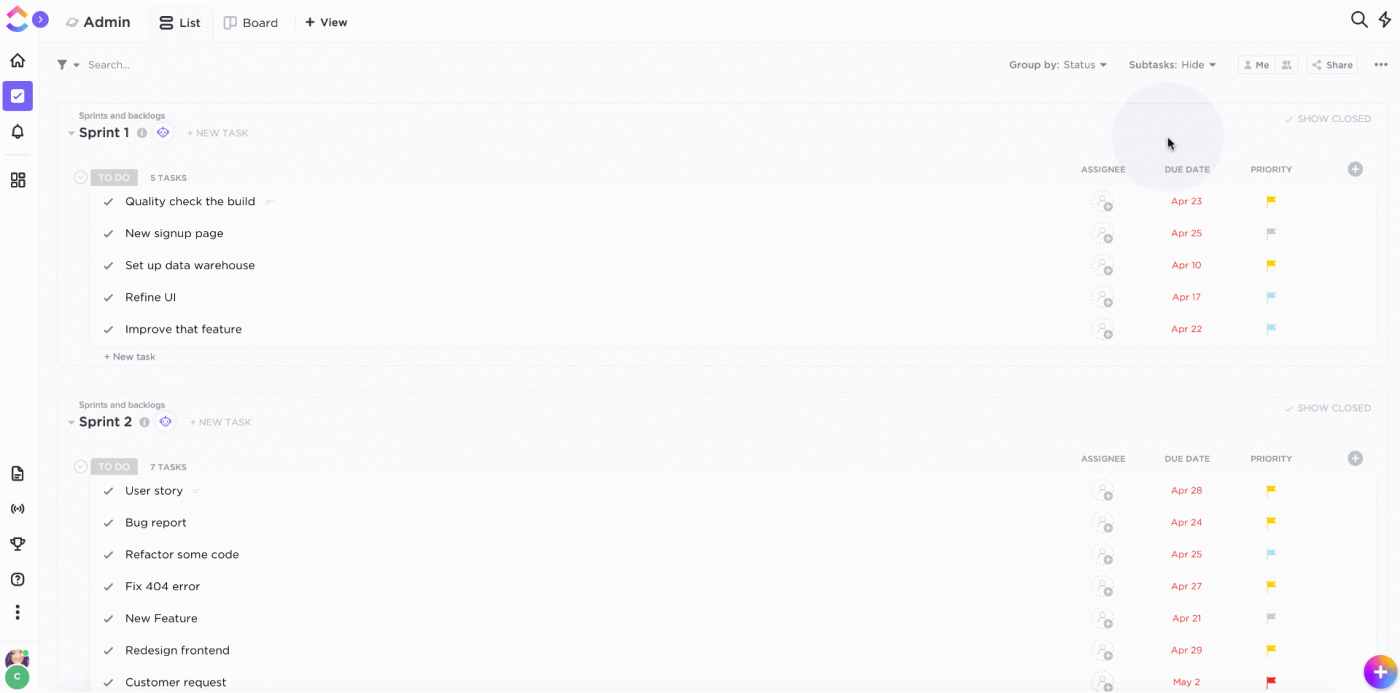
تسهّل القائمة المنسدلة لنقطة سكروم في ClickUp على الفرق تتبع ومراقبة مدى تعقيد العمل المنجز
بمساعدة ClickUp، من السهل إضافة حقول مخصصة بقيمة "رقم" لتقييم وتحديد العمل المقدر لكل مهمة على أساس رقمي (أي 1-5 مع كون 5 هي الأصعب). تُستخدم هذه العملية في إدارة مشروع سكرم ولكن يمكن أن تعمل بالمثل مع فريقك أيضًا!
تحديد أولويات اليوم
ربما تخطط للمهام المهمة لفترات طويلة، مثل الأسابيع أو حتى السنوات. لكن هذه الطريقة تساعدك على التعامل مع خطة مهامك للأسبوع يومًا بيوم:
- قبل أن تنهي يومك، حدد أهم المهام التي يجب عليك القيام بها في اليوم التالي (ست مهام على الأكثر)
- حدد أولويات المهام بناءً على أهميتها
- في اليوم التالي، ركز على المهمة الأولى في القائمة ولا تنتقل إلى المهمة التالية قبل الانتهاء من تلك المهمة، وهكذا دواليك
- في نهاية اليوم، انقل العمل غير المنجز إلى قائمة اليوم التالي - سواء كانت مهمة واحدة أو عدة مهام - وكرر العملية برمتها
3. استمر في تعديل أولوياتك
إذا كنت تريد أن تتعلم طريقة حول ترتيب أولويات المهام، فإن القدرة على التكيف هو أمر يجب أن تتقنه. لأنك لا تعرف أبدًا متى سيظهر أمر تغيير أو مشكلة غير متوقعة في الفريق أو العمل أو المنتج.
ولكن يمكنك إعداد نفسك للأحداث غير المتوقعة التي تغير أولويات المهام. قم بتطوير عادة مراجعة أولويات المهام ووضع نظام لعدم نسيان القيام بذلك بشكل متكرر.
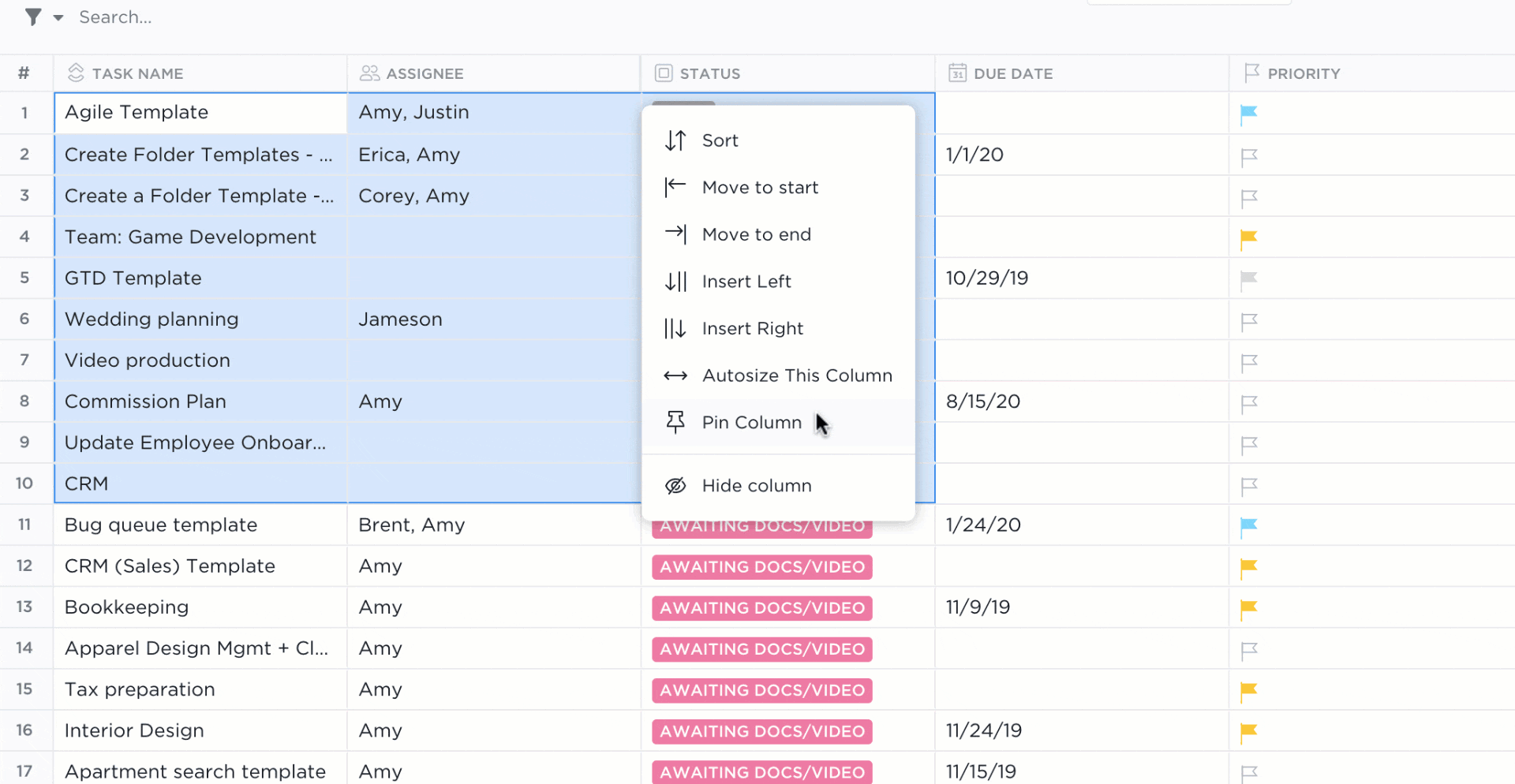
سحب المهام وإفلاتها على جدول النقر فوق طريقة عرض جدول النقر لتنظيم بسيط
راجع أولويات المهام كل يوم في بداية اليوم أو نهايته. ولكن إذا كنت تفضل ذلك، فقم بذلك بعد ظهر يوم الجمعة للأسبوع التالي وراجع الأولويات بنهاية كل يوم.
تجنب مضيعات الوقت المستمرة مهارات إدارة الوقت هي مفتاح رئيسي لتحديد أولويات مهامك. اترك المهمة التي توقفت فجأة عن كونها أولوية، حتى لو كنت تشعر بالرغبة في إنهائها وقد بذلت بالفعل الكثير من الوقت والجهد فيها. سيكون إهدارًا للوقت وقد يضر بالموعد النهائي للاستمرار في القيام بمهمة ليست ذات أولوية، خاصةً عندما تصبح مهمة أخرى هي الأولوية.
4. قدر جهدك بشكل واقعي في إنجاز المهمة
هل تقديراتك للجهد الذي تبذله مدعومة بسجل حافل بأوقات إنجاز المهام؟ حسنًا، إذا لم يكن الأمر كذلك، فيجب عليك البدء في تتبع تلك الأوقات لأنك ستحتاج إليها حتى لو لم تقم بترتيب المهام حسب الجهد المبذول.
تتبع الوقت اللازم لإكمال مهامك باستخدام ClickUp's ClickUp برنامج تتبع وقت المشروع . بعد ذلك، قم بتنقيح تقديرات جهدك بناءً على هذا السجل.
![]()
سجل الوقت أثناء التنقل أو أدخله يدويًا باستخدام تتبع الوقت في ClickUp
تحتاج إلى تخصيص الموارد بناءً على معايير مختلفة، وعلى الأرجح سيكون أحد هذه المعايير هو الوقت المستغرق في المهام.
آخر شيء تريد القيام به هو وضع تقديرات غير واقعية للجهد والوقت لفريقك. سينتهي بك الأمر التسرع في تنفيذ المشروع مما سيؤدي إلى حدوث أخطاء.
5. تعرّف على حدود إنتاجيتك وضع في اعتبارك التوازن بين العمل والحياة الخاصة بك
لا يوجد الكثير مما يمكنك القيام به في يوم واحد أو حالة ذهنية معينة. عادة ما يكون يوم العمل النموذجي ثماني ساعات. وكلنا نواجه جميعًا كتلًا إبداعية من حين لآخر. بالإضافة إلى ذلك، لا يمكن لمعظمنا تقديم أداء عالٍ أثناء الشعور بالتوتر.
في بعض الأحيان يكون تأجيل مهمة ما أكثر إنتاجية من تأجيل مهمة ما إلى اليوم التالي أو ببساطة إسقاطها. ولكن، بالطبع، هذا ممكن فقط إذا لم تكن مهمة حرجة أو مهمة وعاجلة لا يمكنك تفويضها أو إعادة تعيينها.
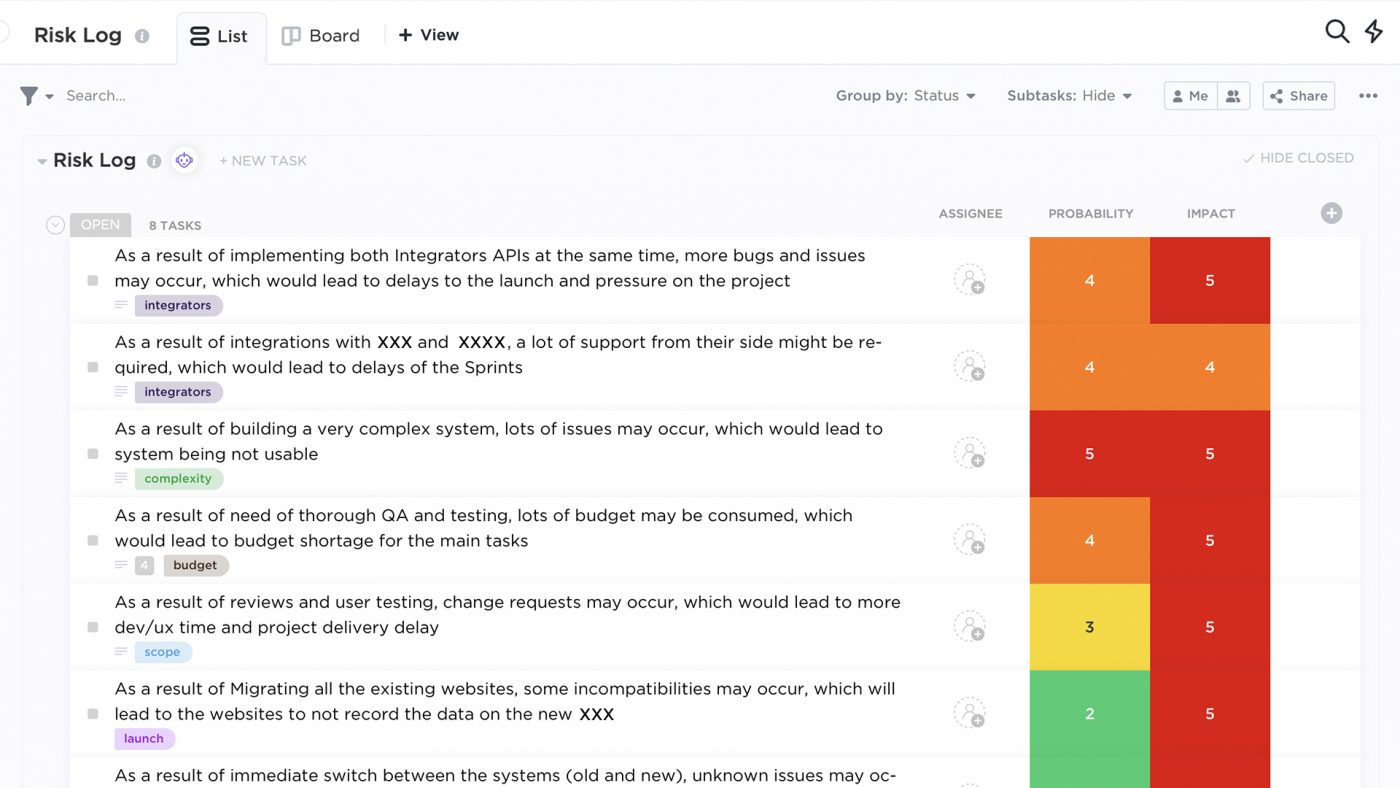
استخدم سجل المخاطر في ClickUp لمعرفة المهام أو المهام الفرعية المعرضة لخطر التأخير أو عدم الإكمال
يمكن أن يساعدك استخدام سجل المخاطر بجدية في فهم تأثير واحتمالية عدم اكتمال مهام فرقك (أو مهامك الشخصية) إذا كانت غير مكتملة. يمكن أن يساعدك فهم المخاطر المحتملة في فهم الإنتاجية الإجمالية لفرقك بشكل أفضل.
نصيحة محترفي أسئلة المقابلات: من الأسئلة الشائعة في مقابلات العمل: كيف تحدد أولويات عملك؟ تغلّب على هذا السؤال في كل مرة من خلال إظهار قدرتك على التفكير النقدي والاستراتيجي لمدير التوظيف. اشرح كيفية تقييمك لأهمية وإلحاح كل مهمة، وكيف تحدد أولويات عبء العمل بناءً على هذه العوامل. اعرض مهاراتك التنظيمية وقدرتك على إدارة أولويات متعددة في آنٍ واحد دون أن تطغى عليها.
6. قم بجدولة جميع مهامك ومهام عملك
يجب أن تكون جدولة المهام عنصرًا في قائمة مراجعة إدارة المشروع . تبدأ بتحديد تاريخ بداية وتاريخ نهاية لكل مهمة في قائمة المهام ذات الأولوية. وتناسب عدة أغراض، من إضافة المهام إلى التقويم الخاص بك إلى إدارة أعباء العمل.
إذا كنت قد أضفت بالفعل تاريخ استحقاق لكل مهمة، فلا مشكلة! فأنت في الواقع تحتاج إليها كمرجع لتحديد تواريخ البدء والانتهاء.
قد ترغب في إنهاء مهمة واحدة قبل تاريخ الاستحقاق لحساب التأخيرات غير المتوقعة. ولكن دعنا نعتبر أن هدفك هو إنهاء المهام على الأقل بحلول تاريخ استحقاقها.
الآن، يعتمد إكمال كل مهمة بحلول تاريخ الاستحقاق على قدرتك. ويعتمد أيضًا على ما إذا كانت لديك أولويات متزامنة. لكن لا يمكنك استخلاص استنتاجات قوية بشأن قدرتك وأولوياتك إلا بعد جدولة مهامك في تقويمك.

احصل على نظرة عامة عالية المستوى حول كيفية تقدم المبادرات المتوافقة مع أداة المحفظة في ClickUp
من خلال توزيع المهام على مدار الأيام، يمكنك تتبع التقدم المحرز مقابل المواعيد النهائية. ونعني بـ "التقدم" المدة (عدد أو النسبة المئوية للأيام) المتبقية على تاريخ الانتهاء. ومع ذلك، إذا قمت بتسجيل العمل في كل مهمة من مهامك، يمكنك أيضًا تتبع التقدم المحرز مقابل الجهد المبذول (المقدر بالساعات الشخصية).
إن تصور التقويم الخاص بك فعال للغاية في معرفة ما إذا كان بإمكانك القيام بالمزيد من المهام. وإذا كنت قد وصلت بالفعل إلى الحد الأقصى لعبء العمل الخاص بك، فستحتاج إلى المساعدة الإضافية (لا يوجد سوى ساعات كثيرة في اليوم).
لإدارة المهام وتحديد الأولويات بفعالية، قم بجدولة كل شيء بما في ذلك المهام الشخصية ومهام المشروع الداخلية والخارجية على حد سواء.
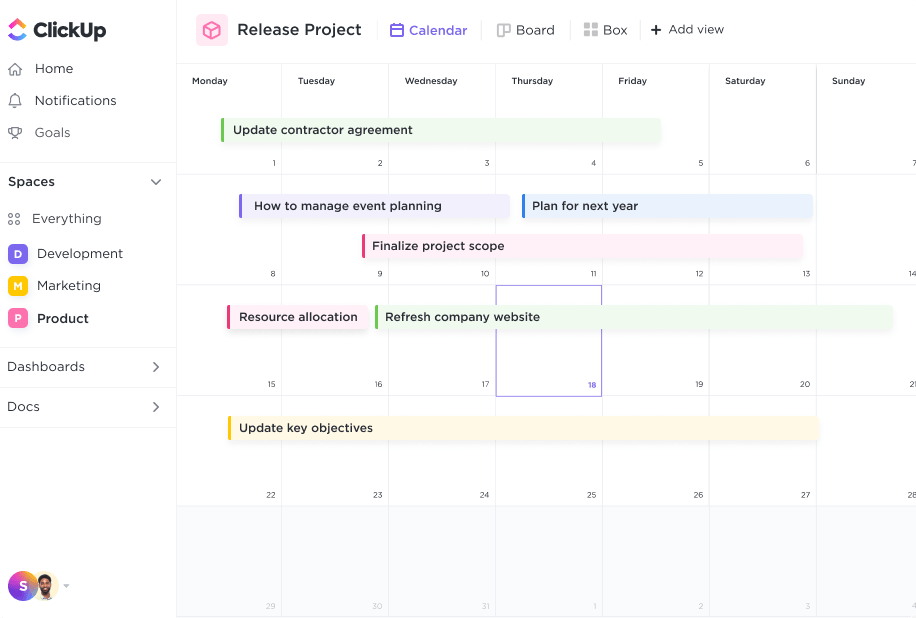
نظّم المشاريع، وخطط الجداول الزمنية، وتصور عمل فريقك على تقويم مرن يبقي الجميع على نفس الصفحة
إذا اخترت ClickUp، ستتمكن من جدولة الاجتماعات الأسبوعية (والتذكيرات اليومية) مع المهام المتكررة. ولكن يمكنك الذهاب إلى أبعد من ذلك باستخدام عرض تقويم ClickUp لجدولة مهامك اليومية (أو الأسبوعية أو الشهرية). وإذا كنت تفضل عرض جدول زمني أو جدول (أو جدول بيانات)، فإن ClickUp لديه هذه الخيارات أيضًا.
أخيرًا، يحتوي ClickUp على عرض عبء العمل لموازنة عبء العمل الخاص بك مثل السحر. حدد الأيام التي تكون فيها بالفعل، أو على وشك، أو على بعد أميال من أن تصبح مثقلاً بالعمل. ثم تصرف وفقًا لذلك: جدولة المزيد من المهام في الحالة الأخيرة وتغيير المهام في الحالة الأولى.
7. خصص وقتك لإنجاز المزيد من العمل
قم بجدولة مجموعات من الوقت لإنجاز مهامك دون انقطاع. هذا يمنعك من تعدد المهام، وهو القطب المعاكس لاستراتيجيات تحديد أولويات المهام.
قم بتنفيذ مهمة مشروع ضمن كل واحدة من تلك الكتل الزمنية أو حتى مهمة لا تنتمي إلى أي مشروع. يمكنك أيضًا العمل على مهام متعددة خلال كتلة زمنية واحدة، ولكن يجب أن تكون مهام صغيرة وغير مرتبطة ببعضها البعض.
تتبّع وقتك وجدولك الزمني بسهولة باستخدام قالب جدولة حظر الجدول الزمني من ClickUp
كتل الإشارة الزمنية في تقويمك المشترك على أنه "وقت التركيز" وإيقاف الإشعارات خلال ذلك الوقت. إنها طريقة لكي لا يزعجك زملاؤك ومديرك أثناء تركيزك على إكمال مهامك، خاصةً المهام ذات الأولوية القصوى.
إذا اخترت ClickUp لإدارة مهامك، فكر في استخدام قوالب حظر الوقت .
8. تواصل مع فريقك حسب الحاجة
إن معرفة كيفية تحديد أولويات المهام هو أحد الركائز الأساسية للعمل بفعالية داخل الفريق. وإلا كيف يمكن أن تقوم بحلقة في الفريق عندما ينتظرون بدء عملك أو إنهاء عملهم؟
وكيف سيشعرون إذا أبقيتهم ينتظرون إنجاز مهامك إلى ما لا نهاية؟ يجب عليك تنبيه زملائك في الفريق كلما واجهت تأخيرًا في إنجاز مهامك. وأخبرهم متى تخطط لإكمال تلك المهام.
يجب عليك أيضًا إبلاغ مديرك بأي عائق تصطدم به أثناء أداء مهامك. فمن واجبهم مساعدتك في التغلب على تلك العوائق.
حوّل التعليقات إلى مهام ClickUp أو قم بتعيينها لتحويل الأفكار إلى عناصر عمل على الفور
ClickUp ممتاز لمشاركة التحديثات والمتابعة من خلال التعليق على مهام محددة. ويمكن أن تتضمن هذه التعليقات تسجيلات الشاشة التي يمكنك التقاطها داخل الأداة. أو يمكنك تعيين تعليقات لزملائك في الفريق لإعلامهم بأنك تنتظر منهم إنهاء مهمة ما.
3 قوالب تحديد أولويات العمل الموفرة للوقت
ستستفيد قوالب ClickUp التالية من النظرية الكامنة وراء طرق تحديد الأولويات التي تعلمتها للتو:
1. قالب ClickUp "إنجاز المهام
يساعدك قالب "إنجاز المهام" (GTD)، المستند إلى نظام "إنجاز المهام" (GTD) الذي وضعه ديفيد ألين، على تنظيم المهام والمشاريع من خلال تسجيلها وتقسيمها إلى عناصر عمل قابلة للتنفيذ
ال نموذج ClickUp لإنجاز المهام هو قالب شامل لتحديد أولويات المهام وتتبعها في مكان واحد. وهو قابل للتخصيص بدرجة كبيرة باستخدام حقول مخصصة، كما يتيح لك التعاون في المستندات مع أعضاء الفريق الآخرين.
تحقق من هذه
_مراجع/ https://clickup.com/blog/gtd-apps// تطبيقاتGTD *%مراجع/_
_و
/مرجع/ https://clickup.com/blog/gtd-templates// قوالب_GTD *%/href/_
!
يمكنك استخدام هذه المهمة قالب تحديد الأولويات إلى:
- تقسيم المهام إلى فئات - أو سياقات، وفقًا للقالب - يمكنك إنشاؤها من الحقول المخصصة
- حافظ على الانضباط وحدد أولويات المهام حسب السياق وتاريخ الاستحقاق والمدة التقديرية ومستوى الجهد
- جدولة المهام في عرض التقويم
- تنظيم المهام في لوحة كانبان القابلة للتخصيص حسب الأولوية
2. قالب مصفوفة جهد تأثير ClickUp
يتيح لك استخدام مصفوفة جهد التأثير إنشاء تمثيل مرئي للجهد المطلوب لكل ميزة حتى تتمكن من تحديد أولويات المهام والموارد بشكل أفضل
إذا لم يكن لديك وقت كافٍ لتقييم أولويات مهامك بدقة، فهذا القالب مثالي! القالب قالب مصفوفة الجهد المؤثر ClickUp يساعدك في تحديد أولويات المهام حسب مقدار الجهد اللازم لإكمالها.
بالنسبة لأولئك الذين يحتاجون إلى تقييم تأثير المشروع أو تكلفته بسرعة، يساعدك هذا القالب على تحديد ما يجب أن تكون له الأولوية. قم بمحاذاة فريقك لفهم ما هو الأكثر أهمية لنجاح فريقك الجماعي باستخدام هذا القالب المرئي.
3. قالب مصفوفة أولويات ClickUp
قم بتحسين كفاءة فريق العمل وإدارة مواردك لتحديد أفكارك ومفاهيمك ومهامك التي تحتاج إلى أكبر قدر من الاهتمام
لقد صممنا قالب مصفوفة تحديد الأولويات في ClickUp لتحديد أولويات قائمة مهامك وفقًا لأي معيارين تختارهما. على سبيل المثال، صنف مهامك حسب مستويات الأهمية وإمكانية الإنجاز، من الأقل إلى الأعلى. بعد ذلك، ستكون مهامك ذات الأولوية العالية هي المهام ذات الأهمية العالية وإمكانية الإنجاز.
اعتمد أيضًا على الألوان لتصنيف المهام. على سبيل المثال، قم بإعطاء لون مختلف للمهام من مختلف المشاريع. هذه طريقة لتحديد أولويات جميع مهامك من مشاريع متعددة في مكان واحد.
ابدأ في تحديد أولويات المهام لتحسين سير عملك
هذه نصيحتنا: اتبع تحديد أولويات المهام الخطوات والطرق في هذا الدليل. وبعد ذلك، انتقل إلى الخطوة التالية وجرِّب ClickUp، وهو برنامج أتمتة المهام الحل اشترك في ClickUp اليوم ! لأن معرفة كيفية تحديد أولويات المهام أمر ضروري للحد من التوتر والتوقف عن العمل تحت الضغط. ولكن فقط عندما أتمتة المهام هل ترى القيمة الكامنة وراء قائمة المهام ذات الأولوية و مهام النقر فوق المهام !


